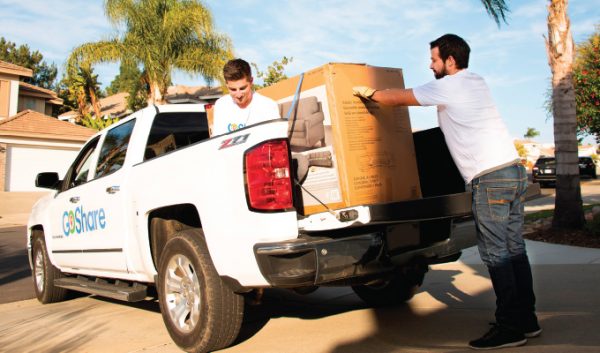Technology is evolving the trucking industry. Dynamic routing software optimizes dispatching. Collision mitigation technology makes roads safer. Dash cams provide protection in the case of collisions and phony insurance claims. GPS tracking of trailers and cargo allows for better asset management.
On-demand service technology is the latest innovation to enter the logistics and transportation space. New, on-demand delivery matching platforms connect local fleets and independent contractors with businesses and consumers in real time.
These platforms enable shippers and drivers to create and accept last-mile and middle-mile delivery load requests in moments. For shippers, these services offer new convenience and solutions for time-sensitive projects. For fleet managers, they represent a new revenue stream and a way to connect with new customers.
RISE OF ON-DEMAND
According to the American Community Survey from the US Census Bureau, the on-demand economy is responsible for $57.6 billion dollars in annual spending. On-demand services include music and video streaming, ebooks, online banking, travel booking, and more. Do you remember when you had to drive to a physical bank to deposit a check? Now you simply take an image with your phone.
To be an on-demand service, a platform must satisfy two important customer needs. First, the customer should be able to make a request, often digitally, for the service quickly and easily. Second, the service should be available almost immediately or at the time of their choosing.
While on-demand technology was first notable in the digital space with streaming music and video content, it has transformed the service sector as well. Instead of just ordering digital content on demand, physical services can be now requested in moments.
Ridesharing and food delivery are good examples of on-demand technology in action in the services sector. While hailing a taxi cab from a corner or calling a pizza delivery place has always been an option, on-demand technology services have expanded these conveniences.
Now, individuals can use a smartphone to hail a ride, even if they aren’t on a busy street corner. They are no longer at the whim of someone pulling over, pickups are more predictable. Payment is made seamlessly in the app, and rates are agreed upfront.
The ridesharing industry actually made hailing a ride so easy and convenient, that it expanded the market. According to the Bureau of Labor Statistics’ Consumer Expenditure Survey, the amount the average American household spent on local taxis tripled between 2015 and 2018 thanks to the widespread adoption of on-demand ridesharing apps.
The restaurant industry is seeing a similar effect from the influence of third-party on demand services offering pickup and delivery. According to a research organization, the NPD group, online ordering is the fastest-growing source of sales for restaurants. While restaurant visits remain flat, digital orders are growing consistently by 20% year-over-year.

ON-DEMAND LOGISTICS
Now, on-demand technology has moved into the transportation industry, allowing shippers to connect with drivers instantly and request immediate services and support.
Businesses and customers using on-demand services generally request same day pickup, often within the hour. Finding a fleet with available capacity for these rush projects would be difficult using traditional methods. But by using on-demand technology, finding immediate service is very achievable.
On-demand platforms rely on large, virtual networks to ensure there are always available delivery professionals to assist with the many last-minute and urgent project requests. Load details are pushed out to nearby contractors and fleets in real time. This allows shippers to instantly get their project details in the hands of dozens of nearby drivers. They are matched quickly to a driver with the capacity and availability to take their load.
Major retailers, suppliers, and distributors across the country are adopting these on-demand platforms as part of their supply chain network. In addition to business clients, individual users are also turning to these platforms as a solution for last‑ mile delivery and personal projects.
Most on-demand platforms are user agnostic. This allows individual users to also hire professional services. They are guided through the process and helped to create a standardized project request and get a clear estimate for the services. So long as they have a verified payment method and their project meets the standards of the platform, it will be pushed out to professionals within the virtual network.

FLEET OPPORTUNITIES
The rise of on-demand technologies in the logistics spaces creates an opportunity for fleet managers. These new technologies are not competitive to existing fleets. Rather, they are an ideal partner for them. On-demand service platforms have loads, but don’t employ drivers or maintain vehicles.
Forward-thinking fleet managers are positioned to benefit from new on-demand technologies. By partnering with on-demand platforms, fleets have a new resource to find projects and loads for their trucks and vans.
Fleet managers using on-demand services are able to keep their trucks and vans moving on slow days by accepting same-day projects and keeping idle vehicles active.
On-demand services aren’t a fad, and they aren’t going away. As adoption spreads, fleet managers should look for opportunities to benefit from this new technology and the additional revenue streams it provides.
About the author
Shaun Savage is the CEO and founder of GoShare. GoShare’s proprietary mobile and web apps connect local businesses and consumers with truck and van owners in real time, offering an on-demand, virtual fleet. GoShare supports local businesses and economies by providing a strong, hourly wage and flexible hours to drivers while also providing local businesses with same-day, last-mile delivery support, allowing them to be more competitive with national online retailers. Find out more, visit www.goshare.com.




